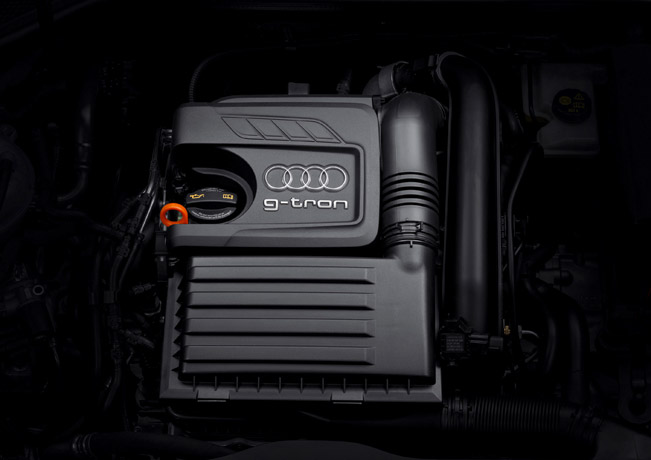Audi A3 Sportback g-tron Supports Renewable Energies
 After the recent introduction of 2014 Audi A3 e-tron the brand is now ready to enter the A3 Sportback g-tron. The latter is a compact five-door car, powered by the CO2-neutral fuel Audi e-gas. This new Audi vehicle innovatively combines ecological balance, economy and high-tech solutions.
After the recent introduction of 2014 Audi A3 e-tron the brand is now ready to enter the A3 Sportback g-tron. The latter is a compact five-door car, powered by the CO2-neutral fuel Audi e-gas. This new Audi vehicle innovatively combines ecological balance, economy and high-tech solutions.
To go further into details, the Audi A3 Sportback g-tron is equipped with the full gamut of company's technology expertise. Starting from ultra-lightweight technology, and infotainment, and ending with the driver assistance systems. However, what is the most important feature here is the state-of-the-art CNG drive technology, with included fuel storage.
The fuel storage has two tanks under the luggage compartment floor. Each of them can hold seven kilograms (15.43 lb) of CNG at a maximum 200 bar pressure. At the same time each tank weighs 27 kilograms (59.52 lb) less than its conventional counterpart.
Even more, the tanks consist of a new type of matrix, where the inner layer comprises of gas-impermeable polyamide polymer, while the second layer - of carbon fiber-reinforced polymer (CFRP) that gives the tank its extremely high strength. In addition, the third layer is made of glass fiber reinforced polymer (GFRP), which provides rugged protection against damage from the outside. High-strength epoxy resin is used to bind the fiber reinforced materials.
Another highlight in the A3 Sportback g-tron is the electronic gas pressure regulator, which is compact and lightweight and therefore reduces the high pressure of the gas flowing from the cylinders down to around five to nine bar in two stages.
For instance, if the pressure in the tank drops below ten barr, the engine management system automatically switches over to gasoline operation. The model is fully bivalent, this means that its performance figures are identical in CNG and gasoline modes.
Furthermore, the CNG provides a range of around 400 km (248.55 miles), with gasoline providing another 900 km (559.23 miles). All in all, the total range is approximately on a par with an Audi TDI.
The information of the fuel level is visible on two displays in the instrument cluster. The driver information system also displays the current fuel consumption based on the particular operating mode.
The engine under the hood of this Audi is based on the new 1.4 TFSI, which develops 110 hp (81 kW) and 200 Nm of torque. Key modifications relate to the cylinder head, turbocharging, injection system, and the catalytic converter.

The Vmax here is 190 km/h (118.06 mph), with an acceleration time from 0 to 100 km/h (0 - 62.14 mph) in 11 seconds. Additionally, the fuel consumption here is also impressive: the five-door car consumes on average less than 3.5 kilograms per 100 km of CNG or Audi e-gas – the fuel that is generated from eco-electricity in the Audi e-gas project. CO2 tailpipe emissions are less than 95 grams per km (152.89 g/mile) in gas mode.
What is more attractive however, is the greenhouse gas balance in a well-to-wheel analysis that accounts for all factors from the fuel source to the car's wheels. When the A3 Sportback g-tron is powered by Audi e-gas, no more CO2 is released. Buyers of the Audi A3 Sportback g-tron will presumably obtain the e-gas at the public CNG refueling stations via an ecological accounting¬ method.
This so called e-gas project makes Audi the first automobile manufacturer to develop an entire chain of sustainable energy carriers. The start of the chain has electricity produced from renewable energy sources and the end products are hydrogen and the synthetic Audi e-gas.
What is more, the construction of the world's first industrial plant to produce synthetic methane (e-gas) from CO2 and renewable electricity is almost complete in Werlte in Germany. The Audi e-gas plant will make a way for tapping into the natural-gas network with its huge capacity as storage and transport system for hitherto excess electricity capacity.
The CO2 used in Audi's e-gas plant is a waste ¬product from a nearby biogas plant, operated by power utility EWE. The CO2, which would otherwise pollute the atmosphere, is chemically bonded into the fuel at the Audi e-gas plant. In addition, it is expected that the e-gas plant will annually produce about 1 000 metric tons of e-gas and will chemically bind some 2,800 metric tons of CO2.
In other words, the CO2-neutral e-gas derived from the plant will be able to power 1 500 new Audi A3 Sportback g-tron vehicles every year. The electricity-gas technology is an aim to significantly foster the expansion of renewable energies.
Source: Audi

















